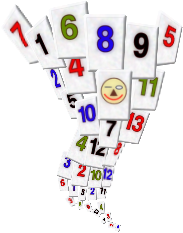Example: Jokers
The following examples illustrate how you can use jokers ( * ). Each example mentions the specific joker rule options that it is valid for.
Suppose the table contains the follwing melds:
And your hand contains: 3 .
If you now move the 8 to the set of 8's, you can re-use the joker as a 4 , and add your card to the run.
Doing so, the table will look like this:
This is not possible with the joker rule You can pick up a joker only after you replace it with a matching card, because you haven't got a real 7 to replace the joker.
Assume the table contains the following melds:
And your hand contains: 24 .
Now you can replace the joker with the 7 from the set of 7's, and use the joker with your cards to form a new run. Afterwards, the table looks like this:
This is not possible with the joker rule The replacing card must come from your hand, because the card that you used to replace the joker came from the table.
Now suppose the table contains the following melds:
And your hand contains: 55 .
Then you can take the 5 and use it with the 5's from your hand to form a set :
This is not possible with the joker rule You cannot remove other cards from a meld with a joker, because you took a card away from a meld that has a joker in it.
If the table contains the following melds:
And your hand contains: 57 .
Then you can free the joker, and use it to place your 7 onto the other meld. The table then looks like this:
This is not possible with the joker rule You can reuse a freed joker only in a new meld with cards from your hand, because you didn't use the freed joker in a new meld.
Assume the table contains this meld:
And your hand contains: 733 .
Now you can free the joker, and use it with your two 3's to form a new set, like this:

